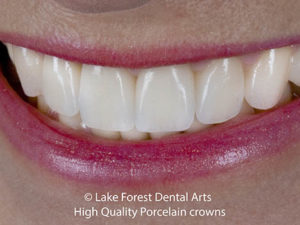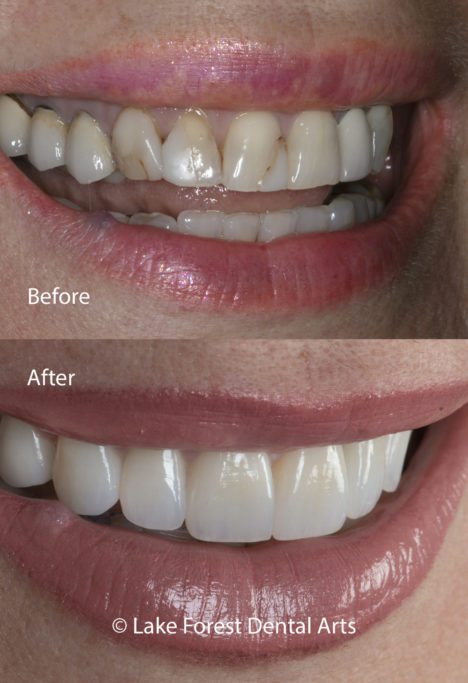
Has your dentist told you it’s time to repair a broken or damaged tooth? Or maybe you are interested in getting crowns as a cosmetic option to hide your smile imperfections? There are many types of dental crown materials. How do you know which option is the best crown selection for your situation?
With several types of crown materials available, it can be difficult to choose. The good news is that a skilled dentist can help you decide based on your unique situation, desires, and goals.
What is a crown and why would I need one?
They are tooth shaped caps that cover the visible part of a tooth. In restorative dentistry, they are used to restore strength, shape, or size to weakened, cracked and broken teeth.
They are also frequently used in cosmetic dentistry. This is because they can improve a tooth’s appearance by covering numerous flaws.
Your dentist may recommend one for any of the following reasons:
- Restore a severely worn down or broken tooth
- Protect a weakened tooth, such as from root canal surgery
- Hold a tooth bridge in place
- Cover a dental implant to replace a missing tooth
- Hide flaws, such as a discolored or misshapen tooth
- Support a tooth with a large filling

Zirconium porcelain crowns can be absolutely beautiful
Factors to consider when choosing the best crown for you
When choosing between the different types, it is important to consider the following:
- The location of the tooth
- The function of the tooth
- Dental crown costs vary based of quality and type
The all porcelain option
When an ideal cosmetic result is needed, porcelain versions are the best crown option. Porcelains such as Emax visually mimics natural enamel and offers many of the same optical characteristics. This gives them a more natural look and provides the most pleasing results. For this reason, porcelain is a good choice for teeth that are visible when you smile and talk.
In addition, it is much more biocompatible than metal, so it helps keeps your gum tissue healthy and happy.
Moreover, porcelain requires the least amount of tooth preparation, allowing you to keep more of your natural tooth.
The downside is that porcelain is vulnerable to damage from excessive stress or force. This makes them the easiest to break or chip. Because of this, all porcelain versions may not be the best choice for back molars that must endure the force of chewing.
Another consideration is cost, as porcelain versions tend to cost more than metallic alternatives.
Metal Crowns
Metal crowns are the best option for those who require the highest degree of strength and durability.
Patients who have the habit of grinding and clenching their teeth (a condition called bruxism) may opt for metal. It may also be the best choice for patients who tend to chew on hard objects, such as ice or pens.
While there are several metal alloy choices, a high noble gold alloy offers the highest quality and strength. It is also the most compatible, so it will not irritate your gums and jawbone like other metals tend to do. While a gold crown is more expensive, it is far superior to non-precious alloys such as nickel or chrome-cobalt.
Aside from the fact that metal is practically indestructible, it is often the most economical choice.
The downside of metal, gold included, is that they are the least attractive. Because of this, it is often best to reserve this choice for back teeth.
PFM restorations
For a best of both worlds option, you may prefer porcelain fused to metal crowns. This involves fusing porcelain to a metal base.
This choice offers the strength and durability of metal while also remaining attractive, and it is the most commonly chosen option.
For those worried about the expense, the PFM version costs somewhere in between all metal and all porcelain options. The determining factor includes the type of metal alloy chosen and the quality and experience of the dental lab.
One downside with porcelain on metal is that the metal can show through, giving a dark line along the gumline. A high quality dentist, however, can remedy this by asking the lab to include a higher porcelain margin.
Another consideration is that the porcelain is vulnerable to chips, fractures, and wear and tear.

Typical design of a dental crown.
When Zirconium Crowns are the best choice
While tooth caps have been around for approximately 2600 years, zirconia made its debut around 10 years ago. During that time, however, zirconium has gained popularity due to it’s superior strength, durability, and beauty.
In fact, zirconia is so strong, it can actually cause damage to opposing teeth. If choosing zirconia, you want a dentist who understands the importance of protecting your natural teeth when placing it.
There are two types of zirconia crowns; monolithic and layered.
Monolithic is a great option for restorative work in the back of the mouth, as it is practically unbreakable. Its extreme strength resists chips, cracks, and breaks, even with significant amounts of pressure and force.
However, while monolithic zirconium can mimic your tooth color, it does not reflect light the way porcelain does. This gives an opaque appearance, which makes them look different from natural teeth. For this reason, most patients chose this option for back teeth only.
For front teeth, layered zirconium offers the most natural and best crown look. These restorations are fabricated with layered lithium disilicate, which dramatically improves their appearance. The layering process allows for the same reflective properties of natural teeth. While not quite as strong as monolithic, it offers stunning beauty when fabricated by a master ceramist.
Find the best dentist to make your best crown
When it comes to cosmetic dentistry, if you want the best outcome, you should pick a high-quality dentist you can trust.
If you are confused about selecting the best crown or have any other dental needs, we would be honored to serve you. Call us at (847) 234-0517 today, and one of our helpful team members can answer your questions and schedule your appointment.
